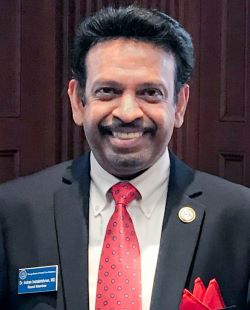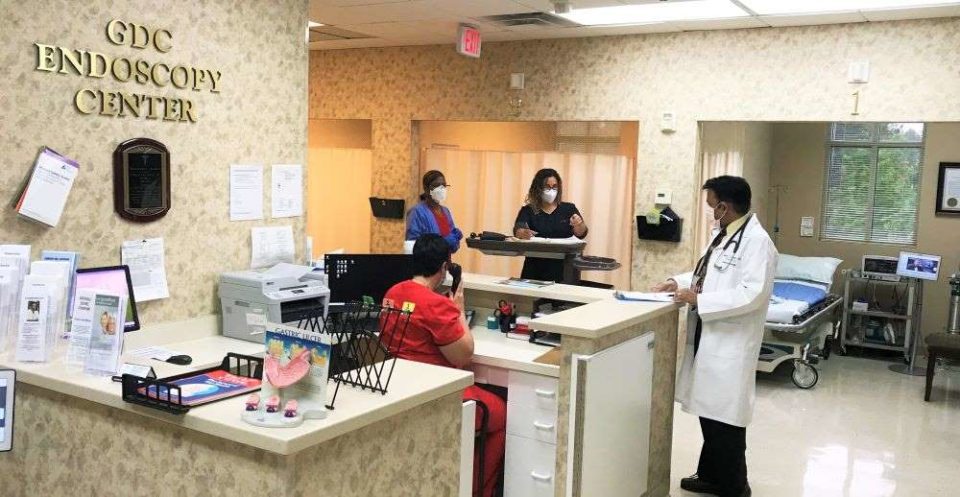This is the second of a five-part series where noted Atlanta gastroenterologist and Emory School of Medicine professor, INDRAN INDRAKRISHNAN, MD* answers questions related to COVID-19.
Cover photo: Physical distancing at Dr Indrakrishnan’s Ambulatory Endoscopy Center.
Will our life get back to normal? Do we have to maintain social distancing for an extended period of time?
The phrase social distancing is a misnomer. I prefer the term physical distancing. We can have very close social relationships through our smartphones and computers– that does not put us at risk of contracting Covid -19. In fact, we need to be closer socially in order to prevent the psychological impact of lockdown and isolation. What matters is physical distancing!
Earlier this week, we witnessed chaos at the Fulton county poll centers where hundreds of voters stood for hours in line for the primary election where they were not able to maintain a physical distance but had good “social distancing” as they did not socially interact with each other. They were still at the risk of contracting Covid-19 because of their close physical proximity to each other. We saw a similar pattern during the recent protest marches across the country.
We sadly reached a grim milestone of 100,000 Covid-19 related deaths in the US last month. The toll continues, even though we see a silver lining – a decline in the death rate in many states.
Social life in the future is going to be challenging. Given the absence of proven effective medication and vaccine for Covid-19, we need to learn to live with this virus as we move forward. Learning to live with and acclimatizing are not new concepts for us—we do that with our spouses, friends, office colleagues and our own children. Why not with the coronavirus as well?
A beautiful and extensive meta-analysis study done in Scotland looking at the worldwide contact tracing studies depicted a stunning revelation. Dr Muge Cevik at the University of St. Andrews from Scotland says that only 10 % of the infected people are responsible for 80% of the infection. She says the risk of infection is alarmingly high in a closed, compact and crowded place with longer duration of exposure. Some typical examples are movie theaters, indoor weddings, parties, restaurants, worship places, funerals, gyms, prisons, public transport, air travel , bars, clubs, indoor family gatherings, buffet, malls, sports stadiums (specially with singing, hugging, shouting and cheering) and grocery stores. These are super spreading events and locations. Hundreds or thousands of people in a closed building with little air circulation can be considered biological bombs. One advice is to avoid these high-risk places if you would like to mitigate the risk of infection. However, we cannot imagine having a social life in the future without any of these and one may even think that dying of the Covid-19 is a better choice! All what we can do and expect is to mitigate the risk by modifying the events and our behavior in a creative manner. It is a harm reduction approach. Outdoor activity is less risky than indoor one in acquiring the infection. An outdoor, warm, humid and sunny (UV light) climate hurts the virus.
Some creative transformations include bringing back drive-in theaters, moving indoor events to outdoor places like parks, mountains, lake fronts and beaches. Restaurants may consider placing tables outdoors, but this may not be practical in the metro Atlanta areas where space could be an issue. Using disposables generously and requesting patrons to dispose them after use can offer some protection to employees. Interactions with people should be brief and to the point as the duration of the exposure per encounter matters. This includes well planned, short visits to grocery stores and avoiding needless roaming around the isles with carts.
Remember, Covid-19 is mainly spread by droplets. Speaking loudly, yelling or even singing can increase the risk of spreading the virus. This is a good time to practice talking softly and calmly with your spouse, colleagues, children and parents! A silent meditation prayer in a spaced-out indoor worship place spreads the virus much less than a packed outdoor political rally with shouting and singing.
An interesting point to note is that rural areas have more land space and less population. Considering vacation spots or even relocating to these areas is another option for some people.
While we adapt ourselves to the new normal to live with Covid-19, it is also equally important to have an ongoing surveillance system to look for new cases and hot spots in order to deter another pandemic crisis in the future. Infectious disease surveillance systems are frequently used by institutions like CDC to gather data for estimating disease rates and geographic distribution of disease. It may not be economically feasible to perform such intense surveillance nationwide forever on Covid-19 given the need for the enormous manpower and the associated shortcomings like test kits. In a NIH funded study, Qu Cheng & et al. at Berkeley University developed a framework for surveillance optimization via simulation in which one can maximize the case detection and population coverage.
In my recent communication with one of the researchers of this project, Rohini Dasan described that they are working to expand this framework to optimize Covid-19 diagnostic test allocation in California, with the intent to improve access to testing amongst those with pre-existing conditions and lower socioeconomic status. If successful, this method can be applied nationwide for Covid-19 targeted surveillance.
Is returning to school safe?
Returning to school is going to be the most daunting affair, particularly in the context of a potential second wave of infection in the fall. The susceptibility for infection within children and from children to adults in the school setting may be different, but we do not have any scientific data on this as most schools were closed before the pandemic peaked.
School buildings pose a very high risk for the spread of infection. As you can imagine, a closed building packed with students will have very little room for physical distancing. Also, the exposure time within them is quite prolonged.
Online classes reduce the risk, but it is also not without its own set of challenges. Clear Internet and WIFI access are still a problem in rural Georgia and not all the families have the financial stability to access the internet and cell phones. Even if the children can connect to computers, educators feel that it is hard to read their body language and facial expressions, and more importantly, to develop relationships.
Mental and academic health may not develop in extended isolation without actual student-teacher interaction. Many kids rely on school meals and they may not get enough nutrition when classes are online.
Making students come to school on alternate days and halve the size of the classes may cut the number of students at any given time. Keeping the windows and doors of classrooms open is another way to circulate fresh air, but the weather may not always cooperate. Making the hallways ‘one-way’ can cut down the risk of face-to-face encounters.
Back home, particularly in rural areas, the classes are held in open spaces outside the school building, frequently under the shades of the trees and this set up is an excellent way to keep the risk of infection to a minimum!
Are we ready to get back to work?
Yes, but it depends on the type of work. We have to adapt to our new reality and manage the work environment. However, this does not have to be perceived as negative and depressing to us.
Contact tracing studies have shown that the risk of contracting the infection is high in a compacted, closed and crowded place, and when exposed for a longer period. Given this information, we may want to keep the doors and windows of the offices open as much as possible for free air circulation. In fact, fans better serve his purpose than air conditioners.
Many who have worked from home in the last couple of months may want to continue to do so as much as possible or consider alternative days’ work from home versus at the worksite, keeping the number of employees low at any given time in the office.
Eating at a cafeteria can be a high-risk affair. You may want to consider taking lunch breaks outside the building or at home. Zoom like technology for virtual meetings has become a norm and if an in-person conference is necessary, space out and keep the meeting time to very brief, cutting social networking.
Receptionists and similar positions are at high risk as droplet transmission is the primary mode of Covid-19 infection and they do have numerous casual encounters daily. Large plexiglass dividers would reduce the risk here and in other similar circumstances where employees have the need to interact face to face frequently.
Keeping distance while talking to others (even with masks on) and letting the talk be brief would be another way to reduce the risk of transmission as the infection risk is higher if the exposure is longer. Frequent social networking of employees as small groups during the work hours is a commonly cited reason for work inefficiency in major companies and government offices and these Covid-19 precautions will hopefully change this pattern!
Deep cleaning at least once a day by supervised professionals is highly recommended. Commuting to work in public transport and carpools increases the risk of infection and alternative measures such as scooters, bicycles or personal vehicles can be considered if walking to work is not an option.
Obviously, staying home when sick needs to be emphasized.

Q&A with Dr. Indrakrishnan will continue next week…
*Dr. Indran Indrakrishnan is a well-known Atlanta based gastroenterologist and clinical professor at the Emory University School of Medicine. In 2018, Dr Indrakrishnan became the first American of Indian descent to receive a commendation from former Georgia Governor Nathan Deal for his exceptional work in improving the lives of Georgians affected by colorectal cancer and other gastroenterological diseases.
The Georgia Senate passed a resolution in 2017 honoring Dr. Indrakrishnan’s service to Georgia. The Georgia House of Representatives followed suit with a resolution declaring February 14th 2018 as Dr Indrakrishnan day.
He was also named among the 25 Most Influential Asian Americans in Georgia twice- in 2016 & 2018.
Dr. Indrakrishnan is a former president and board member of the Georgia Gastroenterology and Endoscopic Society and currently sits on the Georgia Board of Healthcare Force, as well as the boards for Rainbow Village, Fight Colorectal Cancer, Meals by Grace and Hindu Temple of Atlanta. He is also past president of Georgia Association of Physicians of Indian Heritage (GAPI) and currently on the board of trustees.



